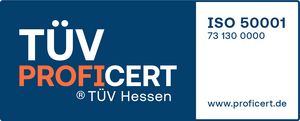All certifications
An ISO 50001-compliant energy management system can be introduced in all companies, regardless of their size or industry, with the objective of continuously improving energy-related performance.
When a company introduces an energy management system, all energy-related processes are analyzed and optimized. In doing so, you introduce a system for making energy flows more transparent. This can then be used to constantly identify and – when possible and economically viable – realize energy-saving potential.
What are the advantages of an energy management system certified to ISO 50001?

The introduction and certification of an energy management system has the following advantages:
- Enables identification of cost-saving potential
- Often a prerequisite for electricity tax refunds
- Image boost
- Increased transparency of energy-related processes
- Increased employee motivation
- Additional acquisition tool
- Lower CO2 emissions
What is the process for certification to ISO 50001 and what are the requirements?
The certification is divided into six steps:
1. On-site readiness assessment
2. Documentation check
3. Certification audit
4. Awarding of certificate
5. Monitoring audit
6. Re-certification
The basic structure of DIN EN ISO 50001 is comparable to that of the environmental management system standard DIN EN ISO 14001 and the quality management system standard DIN EN ISO 9001:2015. Among other steps, companies must define or make statements on the following:
- Energy policy
- Definition of organizational structure and responsibilities
- Definition of energy objectives and measures
- Specification of energy performance indicators for determining energy-related performance
- Collection of energy-related data
- Promotion of expertise and raising of awareness
- Operational planning and control
- Energy-efficient design of systems
- Monitoring and measurement
- Internal auditing of the energy management system
- Assessment of the energy management system and energy-related performance by top management
Can synergy effects be utilized if an environmental management system is also in place?
Utilize potential synergies: You can decide whether to introduce an independent energy management system or to integrate it into an already existing system. Furthermore, as the structure of DIN EN ISO 50001 is absolutely comparable with that of DIN EN ISO 14001 or a quality management system in line with ISO 9001, integration is possible without a great deal of effort.
Would you like further information or a meeting?
Then simply get in touch with us:
TÜV Hessen certification body
Robert-Bosch-Straße 16
D-64293 Darmstadt
Tel. +49 6151 600-331
Fax: +49 6151 600-336
Email: Contact


